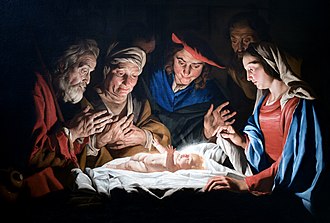|
Jesus Christ Birth Nativity Scene with Virgin Mary and Three Magi
1973 One Troy Ounce 0.999 Fine Silver Bar
By Calvin Massey
The baby Jesus Christ in the hands of his mother Virgin mary surrounded by the Magii and step-father Joseph; star that the magii followed in field to right. NATIVITY Calvin Massey 73 ONE TROY OUNCE.999 FINE SILVER 1973
You are bidding on the exact item pictured, provided with a Certificate of Authenticity and Lifetime Guarantee of Authenticity.
 The nativity of Jesus, nativity of Christ, birth of Jesus or birth of Christ is described in the biblical gospels of Luke and Matthew. The two accounts agree that Jesus was born in Bethlehem in Judaea, that his mother, Mary, was engaged to a man named Joseph, who was descended from King David and was not his biological father, and that his birth was caused by divine intervention. Many modern scholars consider the birth narratives unhistorical because they are laced with theology and present two different accounts which cannot be harmonised into a single coherent narrative. However, many others view the discussion of historicity as secondary, given that gospels were primarily written as theological documents rather than chronological timelines. The nativity of Jesus, nativity of Christ, birth of Jesus or birth of Christ is described in the biblical gospels of Luke and Matthew. The two accounts agree that Jesus was born in Bethlehem in Judaea, that his mother, Mary, was engaged to a man named Joseph, who was descended from King David and was not his biological father, and that his birth was caused by divine intervention. Many modern scholars consider the birth narratives unhistorical because they are laced with theology and present two different accounts which cannot be harmonised into a single coherent narrative. However, many others view the discussion of historicity as secondary, given that gospels were primarily written as theological documents rather than chronological timelines.
The nativity is the basis for the Christian holiday of Christmas and plays a major role in the Christian liturgical year. Many Christians traditionally display small manger scenes depicting the nativity in their homes, or attend nativity plays or Christmas pageants focusing on the nativity cycle in the Bible. Elaborate nativity displays featuring life-sized statues are a tradition in many continental European countries during the Christmas season.
The artistic depiction of the nativity has been an important subject for Christian artists since the 4th century. Artistic depictions of the nativity scene since the 13th century have emphasized the humility of Jesus and promoted a more tender image of him, a major change from the early “Lord and Master” image, mirroring changes in the common approaches taken by Christian pastoral ministry during the same era.
Gospel accounts
Only the Gospels of Matthew and Luke offer narratives regarding the birth of Jesus. Both rely heavily on the Hebrew scriptures, indicating that they both regard the story as part of Israel’s salvation history, and both present the God of Israel as controlling events. Both agree that Jesus was born in Bethlehem in the reign of King Herod, that his mother was named Mary and that her husband Joseph was descended from King David (although they disagree on details of the line of descent), and both deny Joseph’s biological parenthood while treating the birth, or rather the conception, as divinely effected.
Beyond this, they agree on very little. Joseph dominates Matthew’s and Mary dominates Luke’s, although the suggestion that one derives from Joseph and the other from Mary is no more than a pious deduction. Matthew implies that Joseph already has his home in Bethlehem, while Luke states that he lived in Nazareth. In Matthew the angel speaks to Joseph, while Luke has one speaking to Mary. Only Luke has the stories surrounding the birth of John the Baptist, the census of Quirinius, the adoration of the shepherds and the presentation in the Temple on the eighth day; only Matthew has the wise men, the star of Bethlehem, Herod’s plot, the massacre of the innocents, and the flight into Egypt.[4] The two itineraries are quite different. According to Matthew, the Holy Family begins in Bethlehem, moves to Egypt following the birth, and settles in Nazareth, while according to Luke they begin in Nazareth, journey to Bethlehem for the birth, and immediately return to Nazareth. The two accounts cannot be harmonised into a single coherent narrative or traced to the same Q source, leading scholars to classify them as “special Matthew” (or simply the M source) and “special Luke” (the L source).
|





 The nativity of Jesus, nativity of Christ, birth of Jesus or birth of Christ is described in the biblical gospels of Luke and Matthew. The two accounts agree that Jesus was born in Bethlehem in Judaea, that his mother, Mary, was engaged to a man named Joseph, who was descended from King David and was not his biological father, and that his birth was caused by divine intervention. Many modern scholars consider the birth narratives unhistorical because they are laced with theology and present two different accounts which cannot be harmonised into a single coherent narrative. However, many others view the discussion of historicity as secondary, given that gospels were primarily written as theological documents rather than chronological timelines.
The nativity of Jesus, nativity of Christ, birth of Jesus or birth of Christ is described in the biblical gospels of Luke and Matthew. The two accounts agree that Jesus was born in Bethlehem in Judaea, that his mother, Mary, was engaged to a man named Joseph, who was descended from King David and was not his biological father, and that his birth was caused by divine intervention. Many modern scholars consider the birth narratives unhistorical because they are laced with theology and present two different accounts which cannot be harmonised into a single coherent narrative. However, many others view the discussion of historicity as secondary, given that gospels were primarily written as theological documents rather than chronological timelines. 




